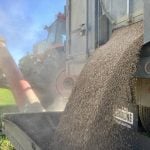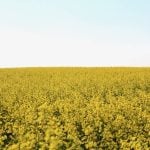It’s not as easy as it used to be to find buckwheat honey in Manitoba. The province was once the buckwheat capital of Canada, with as many as 135,000 acres in 1979, but the area in recent years has been steady around only 5,000 acres. Although there’s demand for buckwheat grown in Western Canada, industry experts say the acres are moving to Quebec and Ontario.
“You get the diehards that grow it every year, and then there’s the odd tire-kicker who wants to try something new. But it’s tough to convince anyone to grow it if canola is at $20,” says Marc Durand, president of the Manitoba Buckwheat Growers Association.
The opening of the new Roquette pea-processing plant in Manitoba last year also diverted some buckwheat acres. Durand says pea ground is similar to buckwheat ground — both crops perform well on lighter soil.
Read Also

Sensing the soil: Root cell research finds ‘stress hormone’
Research into how root cells react to soil stressors could help plants better adapt to changes in their climate.
Angus Kyle owns Springfield Mills in Morden, Man. In 2021, the company contracted about 200 acres of pedigreed buckwheat seed. Kyle says most of their seed went to Quebec and Ontario this year.
“Western Canada is seeing more bean varieties and other types of specialty crops, and with the commodity prices so high, buckwheat gets pushed to the back. There’s a lot of that attitude — that it’s too hard (growing buckwheat), even though the varieties have gotten hardier and have changed,” he says.
Springfield Mills contracts several varieties, including the Agriculture and Agri-Food Canada variety AC Springfield and Horizon, a new large-seeded variety with better yields and test weight than older varieties Mancan and Manor. Kyle says most of his clients are in Washington state in the U.S., from where buckwheat is ultimately exported to the Japanese soba noodle market.
Michael Treytiak, president of DG Global Japan, says the company is trying to develop its western Canadian buckwheat program for export to Japan. Treytiak says the company “had a very difficult time” contracting acres in Manitoba this year. Ultimately, they found some acres in Ontario.
Manitoba’s largest buckwheat buyer is Garland, Man.-based Fyk Soba, which runs a dehulling plant in the Dauphin region. A spokesperson for the company says they’re looking to increase acreage in the province because demand from the gluten-free market is high.
“There are a few customers who are wanting to get more buckwheat, but we can’t supply it because we don’t have enough people contracted,” she says. The company hopes to contract 30,000 acres in 2022.
Needs a bit of stress
Durand says when he works at Ag Days, everyone tells him the old joke about the ice cream truck — drive it past a buckwheat field and the crop freezes. It’s true that buckwheat still doesn’t tolerate frost well, says Durand.
“You have to grow it between the two frosts — you seed June 1 and get a killing frost mid-September. Some seasons it’s a fine line. You have black seeds that come early, but if you have 10 green ones you’ll replace that one black one. It’s always a judgment call when to swath.”
But buckwheat’s relative unpopularity doesn’t necessarily come down to agronomics. The crop boasts plenty of advantages: it’s great for the rotation as it breaks up pest cycles. It’s a very low-input crop and farmers can get it in the ground for $100 to $125 an acre, says Durand.
“If you get a decent yield there is money to be made growing buckwheat. It does better on lighter soil. I can throw in anything I want as far as inputs. I won’t get wheat or canola yields if we don’t get rain, but I can get a good yield in poor conditions.”
Buckwheat can be finicky climate-wise, he says — it needs a stressor at some point in the growing season to set seed. If the weather is too fine, the plant will grow well but not set seed. In a good year you can get 30 bushels per acre, but in a bad year that figure could drop to five bushels, he says. It’s a profitable crop over the long term.
Another limiting factor is the lack of herbicides registered on buckwheat. The only product available is Poast Ultra (sethoxydim), a Group 1 herbicide. The buckwheat industry has been lobbying for more options, with little success.
Durand says most growers harrow or cultivate first thing in the spring, then follow up with glyphosate or another cultivation before planting, but broadleaf and grass weeds can still come through.
Kyle says his late father Lorne Kyle, who was president of Springfield Mills and a founder and longtime director of the Manitoba Buckwheat Growers Association, spent many years trying to increase the profile of buckwheat in Western Canada. Without the acres, companies are unlikely to invest in buckwheat herbicide options.
But Kyle says the nutritional qualities of buckwheat make it a promising option. Many smaller mills in Western Canada grind and dehull buckwheat and market the groats, and their orders have been increasing, he says.
Whether buckwheat can make a strong comeback in Western Canada comes down to producers.
In lieu of attending Ag Days this spring, the Manitoba Buckwheat Growers Association launched a website to raise the profile of buckwheat in the province and serve as a resource on growing and consuming buckwheat. The association can be found online at mbbuckwheat.ca.
















